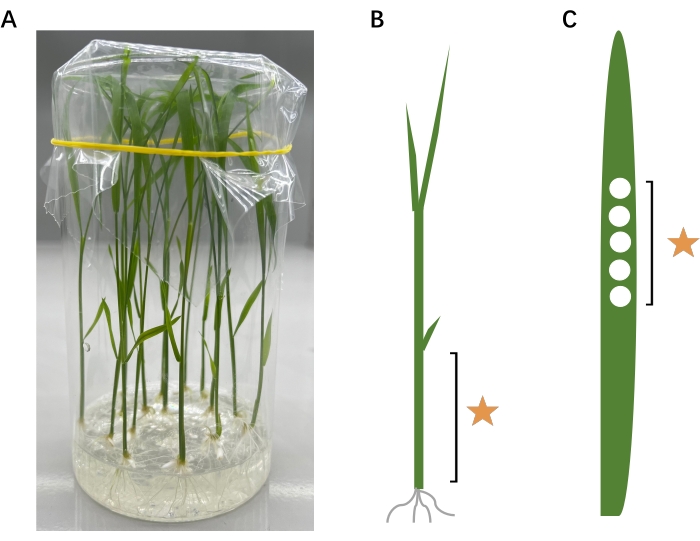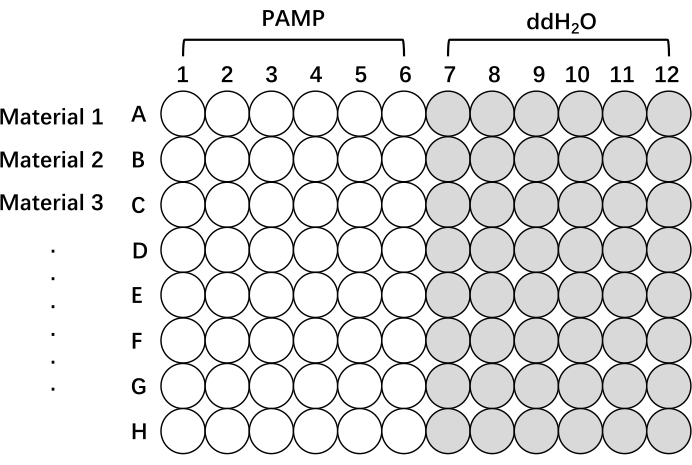An Assay for Detecting Reactive Oxygen Species Production in Rice Tissues upon Immune Elicitation
Abstract
Source: Wang, Y., et al. Real-Time Detection of Reactive Oxygen Species Production in Immune Response in Rice with a Chemiluminescence Assay. J. Vis. Exp. (2022).
This video demonstrates an assay for real-time detection of reactive oxygen species (ROS) production in rice tissues upon pathogen-associated molecular pattern (PAMP) elicitation. Cut sheath segments and leaf discs are exposed to a bacterial flagella-derived peptide functioning as a PAMP. Upon recognition of the peptide via pattern recognition receptors (PRRs) on plant cells, a rapid and transient production of ROS occurs, which is detected via a chemiluminescence assay.
Protocol
NOTE: The protocol is applicable to different plant tissues. Rice sheath and leaf discs were used in this protocol for ROS detection upon PAMP elicitation. As differences mainly arise due to the method of sampling, only the common procedures are described below, with specific steps being mentioned wherever necessary.
1. Tissue preparation and pretreatment
- Rice sheath
- Cut the sheath from 10-day-old rice seedlings into 3 mm segments with a sharp razor blade or surgical blade for pretreatment 1 day before the ROS assay (Figure 1B).
- Place five sheath segments in an individual well of a 96-well microtiter plate containing 100 µL of double distilled water (ddH2O) for 10-12 h, in the dark at 25 °C, which allows wound injury-related ion leakage and defense responses to abate (Figure 2).
NOTE: Taking care to keep the cuts vertical to ensure a consistent cutting surface area exposed to the elicitation solution is an important step to obtaining highly reproducible results. Move the segments gently. Do not make extra cuts or wounds on the segments, which could be a source of data variation. As a principle, each test must contain at least five replicates since the variation of the ROS value is large. The more replicates set, the more reliable the data are.
- Leaf disc
- Cut the leaf discs (4 mm in diameter) from 4-6-week-old rice plants using a biopsy punch with a plunger. Always cut leaf discs from the middle third of the second leaf (numbered from the top) of the main tiller to reduce data variation (Figure 1C).
- Place one leaf disc in an individual well of a 96-well microtiter plate containing 100 µL of ddH2O for 10-12 h for pretreatment, which allows wounding-related responses to abate as these could interfere with the induction of ROS by PAMPs (Figure 2).
NOTE: Operate the leaf discs gently. Do not make extra cuts or wounds on the discs in the experiment, which could result in data variation. The induction of ROS mostly occurs from the cells of the cut edge, since the surfaces of rice tissues (leaves or sheaths) are covered with hydrophobic layers. Only the cells of the cut edges are in contact with the elicitation solution (refer to the discussion section). - Keep all the leaf disks floating, with the abaxial surface facing up, in the wells of a microtiter plate for water pretreatment to avoid leaf side-associated variation.
2. Preparing the elicitation solution
- Dissolve L-012 powder into 20 mM (6.23 mg/mL) aqueous solution with ddH2O to make the stock solution. Then, dilute the stock solution with 50 mM Tris HCl buffer (pH 7.5) to make the working solution at the final concentration of 500 µM L-012. Keep the stock solution frozen and dilute to the working solution before use.
- Prepare the elicitation solution containing PAMP, L-012, and horseradish peroxidase (HRP; 10 mg/mL in ddH2O). For a 10 mL elicitation solution, mix 9.4 mL of 50 mM Tris HCl (pH 7.5) solution, 400 µL of the L-012 solution, 100 µL of HRP, and 100 µL of flg22 (PAMP; 10 mM in ddH2O). For the negative control, add 100 µL of ddH2O instead of PAMP.
NOTE: Keep the prepared elicitation solutions at room temperature to avoid cold stress on rice tissues. Other PAMPs can also be used for treatment as required, such as chitin (20 ng/mL in final concentration). Since L-012 is light-sensitive, cover all the tubes containing L-012 solution with aluminum foil.
3. Starting the software and setting up the protocol with the referenced microplate reader (see Table of Materials)
NOTE: It takes some time to set up the parameters of the microplate reader software. It is recommended to get the machine and protocol ready (one click to proceed) before adding the elicitation solution.
- Start the software. Click the Experiments button to create a new protocol or use an existing protocol.
- Click Procedimiento in the pop-up to set up the plate. Select the wells from the plate to be monitored.
- Click Start Kinetic to set up the total run time and reading interval. Set the Run time to 35 min or longer, depending on the experimental requirements. To obtain readings as frequently as possible, select Minimum Interval. For integration time, choose 1 s or longer, depending on the signal intensity.
NOTE: The reading interval depends on the number of samples and signal integration duration. - Click Validate | OK to confirm the settings.
- Click on Detect the new plate in the pop-up and wait for the software to prompt the load plate dialog box. Place the plate to be tested on the carrier.
- Stop here to wait for the elicitation system to be established (in the next section). As soon as the elicitation system is ready, click on Run to start the reading.
4. Establishing the elicitation system and measuring real-time ROS production
- Carefully remove the ddH2O from the wells containing the pretreated tissues, avoiding any tissue damage or desiccation.
- Use a multichannel pipette to add 200 µL of the elicitation solution to the wells containing the tissues.
- Gently shake to mix. Click Run to begin detection.
NOTE: With PAMP treatment, plant tissues respond and produce ROS very quickly. Therefore, it is suggested that the negative control without PAMP be treated first to reduce the operation time when there are multiple treatments. Operate as quickly as possible to reduce the elicitation delay between treatments. The shorter the time between the addition of the elicitation solution and the start of detection, the better the capture of important experimental data will be.
Representative Results

Figure 1: The growth condition and stages of rice seedlings for sheath sampling and parts of the rice sheath and rice leaves used in the assay. (A) Rice seedlings grown on 1/2 MS medium under sterile conditions for 10 days can be sampled for ROS assay. Sterilized rice seeds were cultured on 1/2 MS medium and grown in a 12 h light/12 h dark photoperiod in A clear glass vial, 8.5 cm in diameter and 15 cm in height. (B) Schematic diagram of the sampling parts of leaf sheaths. Leaf sheaths were cut from 10-day-old rice seedlings. The positions of leaf sheaths were above the roots and below the first leaf. (C) Schematic diagram of the sampling position of leaf discs. The leaf discs can be cut from the middle third of the second leaf (count from the top) of the main tiller of healthy rice plants at any growth stage. Abbreviations: ROS = reactive oxygen species; MS = Murashige and Skoog.

Figure 2: Schematic diagram of the plate setup for measuring ROS production with different lines of Oryza sativa. Pretreatment and test of rice tissues using a 96-well plate. Line 1, Line 2, and Line 3 (up to eight lines on one plate) can be any material of interest, different cultivars, mutants, or transgenic lines. The tissues were stimulated with elicitation solutions with PAMP (PAMP, white) or without PAMP (ddH2O, gray) to measure ROS response. It should be noted that the more the samples to be tested, the longer the time interval between readings. Abbreviations: ROS = reactive oxygen species; PAMP = pathogen-associated molecular pattern; ddH2O = double-distilled water.
Divulgaciones
The authors have nothing to disclose.
Materials
| 96-well microtiter plate | WHB | WHB-96-01 | |
| flg22 | Sangon Biotech | p20973 | PAMP |
| Gen5 | BioTek | software | |
| L-012 | FUJIFILM | 120-04891 | 8-amino-5-chloro-7-phenyl-2,3-dihydropyrido [3,4-d] pyridazine-1,4-dione, CAS #:143556-24-5 |
| Microplate reader | BioTek | Synergy 2 | |
| Peroxidase from horseradish (HRP) | Sigma | P8375 | |
| Sampler | Miltex | 15110-40 | |
| Tris | Sangon Biotech | A610195 |

